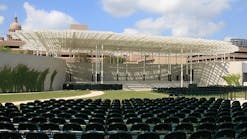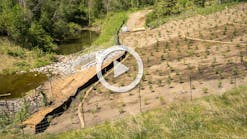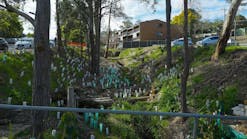Post-Fire Erosion Control Methods in the North San Francisco Bay Area
In total, the North Bay fires of 2017 burned about 40,000 acres. The southern California fires were even larger, totaling 1 million acres. The fires burned a wide variety of landscapes, including whole neighborhoods in flat, urbanized areas. Unlike rural areas, these areas are served by urban infrastructure, including storm drain systems, which tie into natural waterways such as creeks, rivers, bays, and oceans. As part of the engineering community, we observed that the potential for mobilization of ash from burned lots posed a major challenge for communities recovering from urban fires. This article is intended for professionals interested in erosion control and water-quality issues in post-fire areas.
The fires that devastated the North San Francisco Bay Area in October 2017 generated large volumes of ash and debris in subdivisions and on private lots. This material includes toxic compounds and heavy metals such as lead, mercury, and copper from the combustion of homes, cars, appliances, furniture, and other man-made materials.
Aerial application
Traditionally, soil tackifier is used for erosion control of bare soil and for hydroseeding. To our knowledge, it has not been used on ash and debris from fires. However, the application methods would be similar to those for traditional uses. The tackifier can be spread across burned subdivision lots using hydroseeding equipment or commonly found construction equipment such as a mobile water tank (a.k.a. water buffalo), a large 2-inch hose, and a commercial-grade spray nozzle. The tackifier emulsion would be dispersed across the lot until the ash is saturated, at which time the tackifier would begin to harden and bind the ash and small debris into a crust. The curing time for tackifier and soil stabilizers ranges from 4 to 24 hours, making this a quick and responsive means of addressing erosion concerns. The cost of applying the tackifier would be approximately $250 per typical lot of 5,000 square feet (Table 1).
This solution is intended for limiting water-quality problems from ash and debris on flat residential lots with grades between 2% and 5%, such as the Coffey Park neighborhood in Santa Rosa, CA, and is not appropriate for the large-scale hillside slope stability efforts that are necessary to prevent landslides and mudslides that frequently follow fires on steep slopes.
Helicopter loading area
The best time for application of tackifier would be once law enforcement allows safe entrance back into a burned lot immediately after a fire and before debris removal efforts start—and, if possible, before the next heavy rainstorm. For the North Bay fires, the ideal period of application would have been in mid-November before the US Army Corps of Engineers began cleanup work. Once tackifier is applied, a burned lot would be closed to entry until debris removal commences. While the lot waits for debris removal, the erosion-resistant crust would remain in place, preventing the mobilization of the contaminant-laden ash. Care should be taken to choose a soil tackifier that is permeable to water, allowing rainwater to infiltrate through the ash rather than sheet-flowing off it.
After application
Once cleanup begins, crews would break the crust into manageable pieces for collection and off-hauling via truck. By binding the ash particles together into a crust, this method would reduce the effort required to collect ash and debris for disposal and significantly reduce the amount of airborne dust generated. Once collected, the consolidated ash would be transported to a landfill, where it would be disposed of according to current industry practice. The soil tackifier would add a negligible volume to the debris and therefore would have a negligible impact on debris disposal fees at landfills. The soil tackifier proposed is biodegradable, allowing it to be readily acceptable at any landfill, where it will slowly decompose.
Applying tackifier to the burned lots would provide several benefits to federal, state, county, and city agencies in the wake of large urban or suburban fires. By fixing toxic materials in place, this method would protect vital waters of the US from water-quality degradation and fish and wildlife impairment. It would also reduce the higher cleanup costs associated with trying to remove the toxic materials after they have been deposited in the storm drainage systems and our natural waterways. Finally, the tackifier would limit the amount of ash mobilized into the air during debris removal and disposal, reducing the cleanup crews’ exposure to respiratory hazards from toxic dust. In summary, application of soil tackifier to address post-fire challenges would provide multiple environmental and health benefits at low cost. We look forward to investigating this novel use of soil tackifier in collaboration with the rest of the engineering community.












